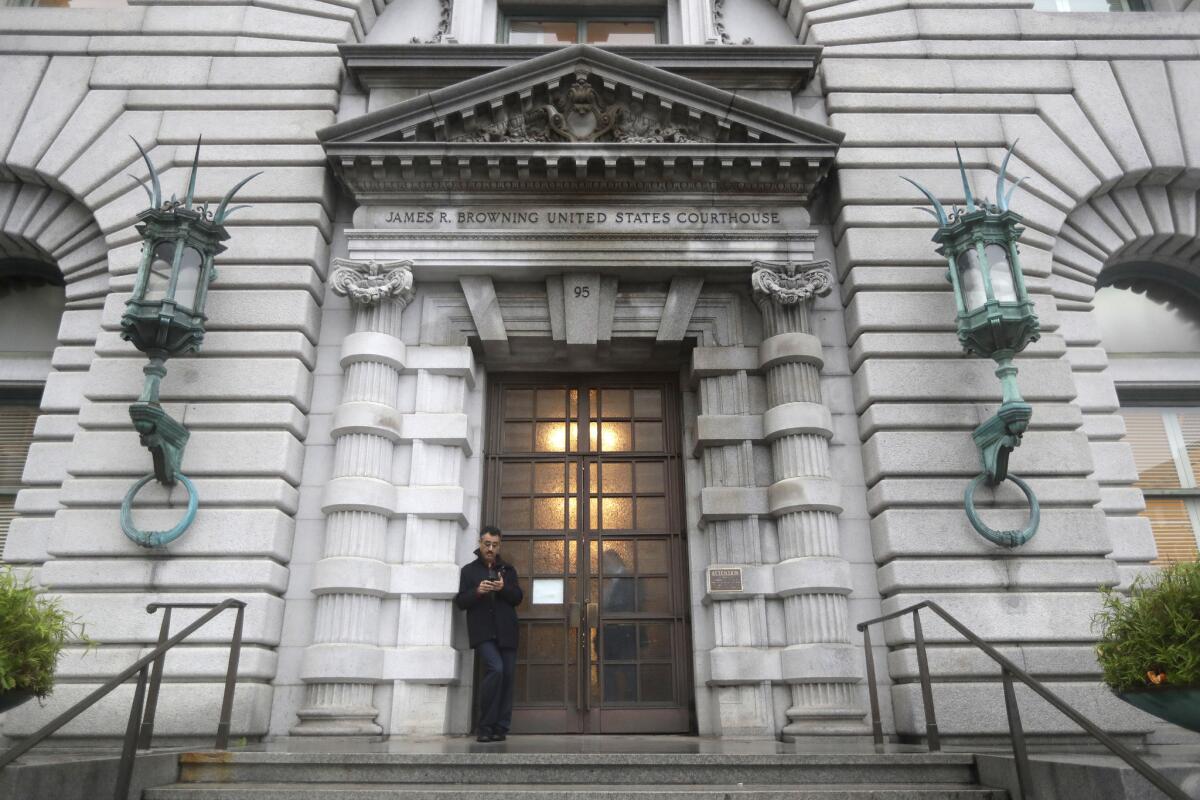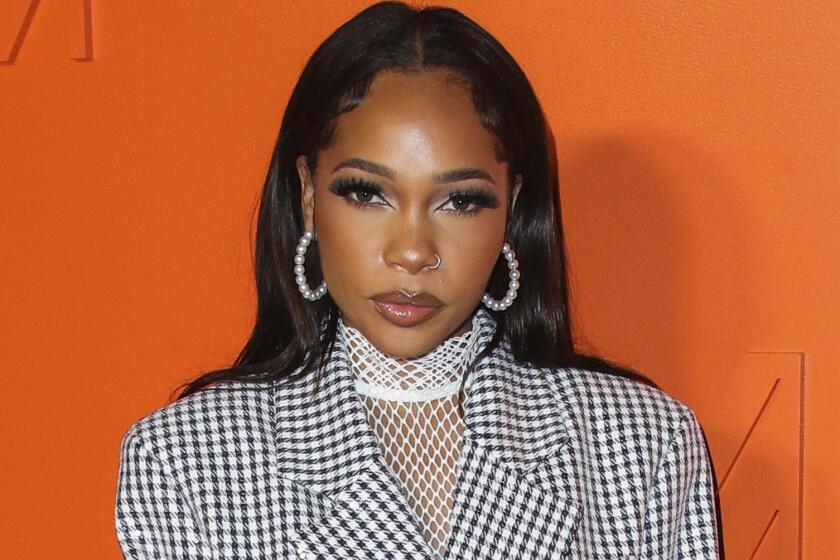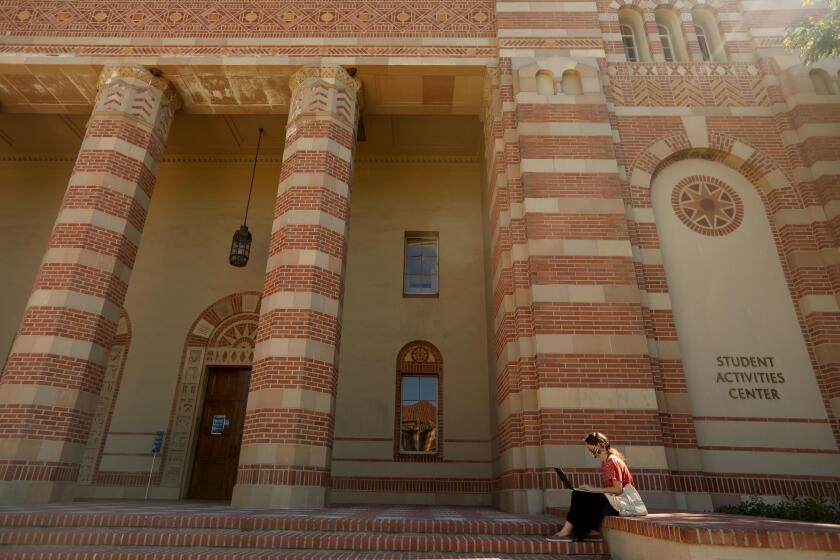Column: Trump having his revenge on California as he remakes once-liberal 9th Circuit court

- Share via
There are the big, juicy political developments, of the sort that require double-sized headlines on front pages and, eventually, their own chapters in history books.
And there are the quiet, incremental ones. But both matter.
Last week, the world watched as articles of impeachment against President Trump were first introduced in Congress, five days before they were approved by the U.S. House of Representatives in a historic vote.
Sign up for Essential California
The most important California stories and recommendations in your inbox every morning.
You may occasionally receive promotional content from the Los Angeles Times.
But something else also happened in the Capitol last week that could affect California, and other western states, for decades to come.
The U.S. Senate confirmed two more Trump nominees to the 9th Circuit Court of Appeals, a powerful federal appeals court long regarded as a liberal bastion. (The reality of that reputation has starkly waned in recent years, but more on that below.)
Judges Lawrence VanDyke and Patrick Bumatay, who are both in their 40s, will serve lifetime appointments. Their ascent to the bench means that Trump appointees now account for more than a third of the active judges on the very same court that the president has repeatedly attacked as being adversarial to his agenda.
The San Francisco-based 9th Circuit is inherently no more powerful than any of the other 12 circuit courts, but it is a whole lot bigger. It has jurisdiction over an area that spans roughly 1.4 million square miles and encompasses more than 60 million people in nine western states and two Pacific Island territories. It’s played an outsize role in American political discourse — serving as both a boogeyman to conservatives, and an icon of judicial activism to those on the left.
The 9th Circuit has been responsible for a plethora of contentious decisions over the years, including a ruling that the mention of God in the Pledge of Allegiance violated the Constitution. That ruling was overturned by the Supreme Court.
The court also wields a great deal of influence over the law of the land for those in its jurisdiction. Think of it this way: Yes, the Supreme Court is the last word. But the Supreme Court hears only about 100 to 150 of the more than 7,000 cases it is asked to review every year. So for the vast majority of disputes, the decision of the circuit court functions as final say.
Much of the 9th Circuit’s now-dominant reputation was shaped during the 1980s, in the wake of President Carter’s remaking of it.
A 1978 expansion of the courts added 10 seats, which were Carter’s to fill — with a Congress controlled by Democrats to back his choices. The regular cycle of judicial retirements, deaths and appointments meant that Carter was responsible for 15 total appointees to the court.
In the natural order of things, four to eight years of a Republican presidency are typically followed by four to eight years of a Democratic presidency (or vice versa), and the shifting pendulum of political appointments accounts for something like rough parity in the judicial makeup.
But the Carter-era expansion of the court was “essentially an external shock to that system,” according to Jon Michaels, a professor of law at UCLA. Carter’s appointments remade a court that had previously been relatively conservative.
And Carter didn’t just choose liberal judges; he installed some of the most liberal judges to ever serve on an appellate federal court — such as Judge Stephen Reinhardt, who remained a crusading force until his death in 2018, or the late Judge Harry Pregerson, who famously played a key role in attaching a vast array of social programs to the construction of the 105 Freeway.
These were men who “approached the judicial role as one where the job was not merely to apply the law as written by the legislature, but also to help balance economic and power disparities in the legal process,” said lawyer Ben Feuer, who serves as chairman of a firm that specializes in California appellate cases.
Under their leadership, the 9th Circuit often issued rulings that not only made headlines but also carved out its place in the popular imagination as an activist court.
But that image has been out of date for a while, since even before Trump took office. The court still leans liberal, but without the fervency of its past.
Feuer posits that this is, at least in part, due to a general trend of the judges appointed by Democratic presidents shifting more toward the center over the last few administrations, while Republicans have continued to appoint judges who are consistently, if not increasingly, conservative. And the Carter-era liberal lions are no longer on the court.
But even with all that said, the makeup of the court has still changed drastically during the Trump years.
As recently as April 2017, judges appointed by Democratic presidents outnumbered Republican appointees on the court by about 2 to 1 (that number probably also includes semi-retired senior-status judges). The court is now edging toward a more even split, with a ratio of 16 Democrat-appointed active judges to 13 Republican-appointed ones.
So what does all this mean for the future? California, as you well know, has a reputation for forging its own progressive path.
The ability to occasionally go a bit rogue, and operate independently from the rest of the nation is made possible, in part, by the sheer size of our population and economy.
But California has “also been able to insulate itself a little bit, because there have been federal challenges that have been brought in courts that have generally been sympathetic to progressive regulation,” Michaels said.
“So that may change,” the UCLA law professor continued. “This might be a time where California is less able to chart a more exceptional route within the country.” But, he explained, all of that depends on what happens next.
If Trump wins another term, we could see the courts further remade — with the potential for a 9th Circuit that ultimately has a conservative majority.
In the meantime, Pregerson and Reinhardt’s former seats have both been filled by Trump appointees.
Judge Daniel Collins, Pregerson’s successor, has represented gas companies in climate change-related legislation and once appeared before the 9th Circuit to challenge a San Francisco ordinance barring tobacco sales in drugstores. He was representing Philip Morris Co.
Anyway, the 9th Circuit upheld San Francisco’s first-in-the-nation ban. But that was then.
Who knows what next time will look like. Most cases are decided by randomly chosen three-judge panels, and there are more than a few foxes guarding the hen house now.
More to Read
Sign up for Essential California
The most important California stories and recommendations in your inbox every morning.
You may occasionally receive promotional content from the Los Angeles Times.











